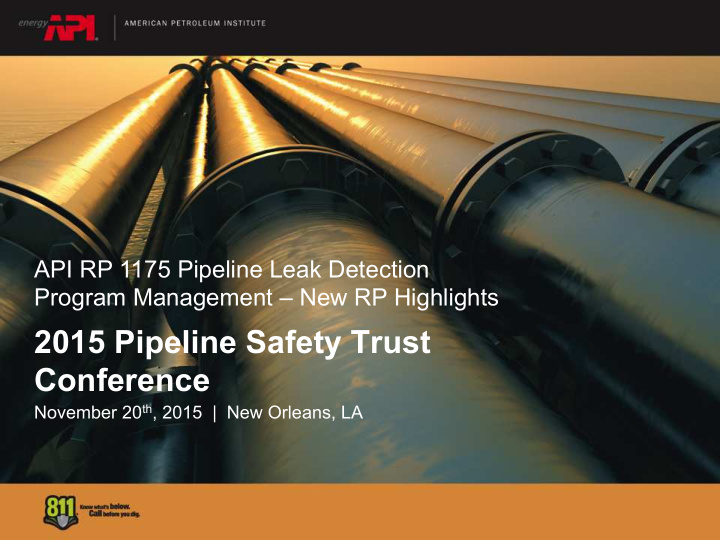



API RP 1175 Pipeline Leak Detection Program Management – New RP Highlights 2015 Pipeline Safety Trust Conference November 20 th , 2015 | New Orleans, LA
Agenda § API Process § Current Status § Intent of API RP 1175 § Proposed RP 1175 Table of Contents § Overview of Sections § Questions/Comments
Document Types § Bulletin/Technical Report – Documents that convey technical information on a specific subject or topic and are generally issued on a one-time basis. § Code – A document intended for adoption by regulatory agencies or authorities having jurisdiction. § Recommended Practice (RP) – A document that communicates proven industry practices. § Specification – A document that prescribes technical requirements to be fulfilled by a product, process, or service. § Standard – A document that provides for common and repeated use, rules, guidelines or characteristics for activities or their results aimed at the achievement of the optimum degree of order in a given context. Standards typically include elements of both specifications and recommended practices.
Current Status § Document has been balloted § All comments being resolved § Targeting 1Q2016 publication
Intent of API RP 1175 § Provide holistic, high-level overview of LIQUIDs Leak Detection Program (LDP) management – Guidance on development, implementation, and management of a program – Enhanced guidance and establishment of performance measures – Address identified gaps and develop a comprehensive LDP document § Focuses on using a risk-based approach § Suggest all forms of leak detection managed in a coordinated manner. § Promote advancement of robust LDPs § Represent industry best practices
Key Definitions § Leak Detection Program (LDP) – Top level term that encompasses all the various leak detection systems (LDSs) (which may include multiple techniques) employed by the pipeline operator and identifies all methods used to detect leaks and the policies, processes, and the human element. § Leak Detection System (LDS) – End-to-end application of one technique that may be internally- based or externally-based and continuous or non-continuous
RP 1175 Sections § Scope Response § Normative References § Alarm Management § Definitions § Roles, Responsibilities, and § Leak Detection Culture and Training § Reliability Centered Strategy § Selection of Leak Detection Maintenance for Leak Detection Equipment Methods § Overall Performance § Performance Targets, Evaluation of the LDP Metric, and KPIs § Management of Change § Testing § Improvement Planning and § Control Center Procedures Process for Recognition and
Leak Detection Culture and Strategy § Culture – Influences how personnel behave and act – Shared – Affects and is affected by the behavior and interactions of people – Includes an organization's beliefs – Evolving § Ongoing management direction and support § Doing every task, the right way, every time
Thinking to Knowing § Strong Leak Detection Culture Indicators: – Support from management – Exceeding minimum regulatory requirements – Ongoing improvement – Coordination of all leak detection methods – Coordination and teamwork between different entities involved – Clear policies, procedures, and processes – Comprehensive management of change – Ongoing training – A focus on the safe and reliable operations of the pipeline with no negative repercussions on the staff who take actions in response to leak indications
Leak Detection Culture and Strategy § Strategy – Outlines the technical aspects – Sets the goals – Details how will be met
Elements of strategy 1. Management 7. Regulatory requirements commitment and and industry standards leadership 8. Ongoing measurement 2. Pipeline operator’s of performance requirements and goals 9. Reporting 3. How requirements and 10. Training, testing, and goals should be satisfied operations / procedures 4. Employing risk 11. Review and approvals management 12. Management of change 5. Selection of leak 13. Ongoing improvement to detection systems the LDP (LDSs) 6. Integration of all LDSs employed
Selection of Leak Detection Methods § Choose appropriate principles, methods, and techniques § Selection of new applications, additional applications, or re- examine existing applications § Multi-step, multi- faceted, and iterative § Documentation is essential
The Process of Selection § Culture and strategy alignment § Performance Targets, Metrics, and KPIs § Regulatory Requirements, Best Practices, and Company Requirements § Overall Risk Assessments § Best Available Technology(ies) § “Fit-for-purpose” § Leak Detection Capability Evaluation (LDCE)
Performance Metrics, KPIs, and Targets Metrics Key Performance Indicators (KPIs) Performance targets
Proposed Metrics § Four leak detection metrics – Reliability – can you depend on the alarms? – Sensitivity – how small a leak can you detect? – Accuracy – how good are the size/location estimates? – Robustness – will it work in a less than perfect environment? § KPIs add specificity
Control Center Procedures for Recognition & Response § Documented leak response procedure – Complementary – Additional guidance § Pipeline Controllers – Front lines – Level of authority and responsibility – Think Teamwork!
A little more § Reinforce all potential leak alarms – Have a cause – Evaluate – Immediate attention § Leak response procedures – Processes, tools, and actions – Consequence-based mindset with directives for taking action – Simple to understand and implement – Be reinforced § SHUTDOWN is always an option
Reporting and Documentation § Log actions § Use a standard form § Utilize in incident investigation
Pipeline Restart § Restart procedure be included in Control Center procedures § Involve – Appropriate authorization – When to restart § High-level of awareness – Extra attention by both field personnel and the Control Center staff
Overall Performance Evaluation of the LDP § Capture noteworthy results of the performance of the LDP § Benchmark § Involve management § Use KPIs
Improvement Planning and Process 1. Identifying and Defining – Identify and capture issues – Look for sources of improvement – Review history 2. Initiating and Monitoring – Review all opportunities, set targets, recommend actions – Plan, budget, schedule, track – Consider the timeframe – Use checklists – Update and improve
Thank you! Stuart Saulters Policy Advisor, API 202-682-8493 saulterss@api.org
Recommend
More recommend